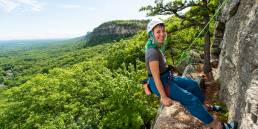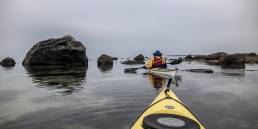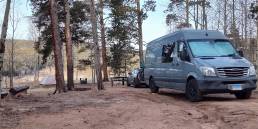There are 157 names on the wall, and we stood there, reading each one in an uneasy silence. This mountain—the one we were currently standing atop—has killed more than its fair share of hikers, climbers, and skiers.
The Sherman Adams Visitor Center’s double doors crashed open, blowing in near-hurricane-force winds and a bone-chilling cold. The man who walked in had a balaclava and ski goggles completely masking his face. The weather had turned overnight from cold-but-manageable to now dangerous, idling at around 25 degrees Fahrenheit, with wind speeds hitting 74 MPH. For a moment, everything seemed to stop, as this mysterious man strolled across the room with the weather appearing to have no effect on him. The rime ice that had been engineered onto the masked man’s shell jacket immediately started melting and dropping off behind him as he made his way to a bench.

There weren’t any hikers or tourists up here today—the weather had turned them all away. So, I assumed he was with the state park. But, that didn’t make sense. I had become quite familiar with the team in the observatory after spending the night in their quarters, having dinner with them, and chatting it up about the weather, gear, Game of Thrones, and The Pats’ upcoming season. I didn’t recognize this guy, and the dayglow orange shell, trekking poles, and Black Diamond gloves were clearly not state-issued.
Sharon hustled over to him. “Hi…I’m Sharon,” she said in a hesitant tone that I hadn’t heard even a hint of since I’d met her the day before. As a Coast Guard commander prior to becoming the president of the Observatory, doubt wasn’t a part of her make-up. Earlier in the morning, she had been warning us that our descent down the Auto Road would be delayed, as they put chains on the Observatory van’s tires. And, there was absolutely no way she could allow our two store staff members, Amy and Eric, to hike back down the mountain. The sight of this man calmly strolling in from the churning weather threw off her game a bit.
“Are you an Observatory member?” she asked incredulously.
“Yeah, I think my name is up on the wall, over there somewhere,” he said and casually strode over to a different wall made of blue name plates lining the stairs that went down to the museum for the Observatory’s top donors and members. His nonchalant attitude toward it added a new layer of curiosity. I turned and looked in the direction of his outstretched trekking pole. “Mike Matty” read the white lettering on the plate.
 “Oh, welcome! I’m the president of the Observatory,” Sharon replied, smoothing her demeanor now that she knew the potential trespasser had literally paid his dues
“Oh, welcome! I’m the president of the Observatory,” Sharon replied, smoothing her demeanor now that she knew the potential trespasser had literally paid his dues
“We have the folks from EMS with us for an overnight. This is Tom,” she said as she introduced my boss.
“I’m surprised you made the trek, given the weather,” Tom commented, clearly still feeling the shock of this stranger ambling out of the roiling weather as if he were coming back from a walk in the park.
“That’s why I came up,” Mike deadpanned. “So, you work at EMS?” Mike asked Tom, our Vice President of Ecommerce and Marketing. “My nephew loves that store.”
I chuckled to myself, as I made my way over to windows in the rotunda. Outside, the rime ice flowered and grew seemingly out of nowhere, carried by the dense cloud enveloping the summit. I felt like I had woken up on a different planet. Not even 18 hours ago, our ascent up the Auto Road had been sunny, calm, and beautiful.

“The home of the world’s worst weather” is a catchphrase Mount Washington has certainly earned. The hike up itself isn’t one the most dangerous or difficult. Rather, this 6,288-foot peak’s volatile conditions are the reason for those 157 names posted in the Adams Center.
The gusts whipping up over the western corner of the deck made it feel like you were stuck in the world’s worst washing machine. A 10-minute, 30-foot trek from the door to the corner and back had exhausted me.
Mount Washington is in a unique position. The highest point east of the Mississippi, it sits directly at the epicenter of a topographical funnel that compresses and accelerates the wind to such an extreme that the 231 MPH wind speed recorded at the summit in 1934 still stands today as the fastest-ever observed by man. It’s even said that the sheer force of the wind tore apart the measuring instruments. Only once was this record ever beaten, at an unmanned weather station in Australia in 1996.
“He’s climbed the seven peaks!” I thought I heard Amy squeal behind me to Eric. She excitedly handed her phone over for a picture with Mike. Amy’s sudden exuberance seemed odd, but I was more focused on the portentous conditions threatening to trap us on the summit. As Eric handed the camera back to her, Mike started reassembling his gear for the descent.
I thought about our earlier excursion out on the deck of the observatory. We had to gear up in MICROspikes to gain some semblance of traction, leaning into frigid, hurricane-force winds. The gusts whipping up over the western corner of the deck made it feel like you were stuck in the world’s worst washing machine. A 10-minute, 30-foot trek from the door to the corner and back had exhausted me.

This guy had hiked all the way up in that, and was about to hike all the way back down, too. I shuddered. Mike adjusted his goggles before punching the exit door depressor. A 15-minute break had been enough to rest, dry off, and get warm before he plunged back into weather that would make the average person cower and yearn for their Uggs and a cozy Duraflame fire.
He was training for bigger things, searching for the conditions to match his more sizable feats, and found them on this windy New Hampshire peak more than 4.5 times smaller than Everest.
Sitting back at my desk on Monday, I couldn’t get the mysterious encounter with Mike out of my head. It was odd. Who was this guy? What did he mean when he said that the weather was the reason he hiked up? So, I did what any red-blooded, digitally inclined American would do.
To my slack-jawed, wide-eyed amazement, the Google results showed that Mike had indeed mastered the seven summits: Mount Kilimanjaro in Africa, Mount Vinson in Antarctica, Kosciuszko in Australia, Elbrus in Europe, Denali in North America, Aconcagua in South America, and, the crown jewel of them all, Everest.
To Mike, the conditions on Mount Washington that day, September 1, were ideal. He was training for bigger things, searching for the conditions to match his more sizable feats, and found them on this windy New Hampshire peak more than 4.5 times smaller than Everest. The harsher the conditions were, the better his training.
Or, maybe that’s just how an outdoor masochist gets some exercise. Who knows.

Patrick O'Malley
Patrick O'Malley is Digital Marketing Manager for Eastern Mountain Sports. He hates talking about himself—especially in the third person.




